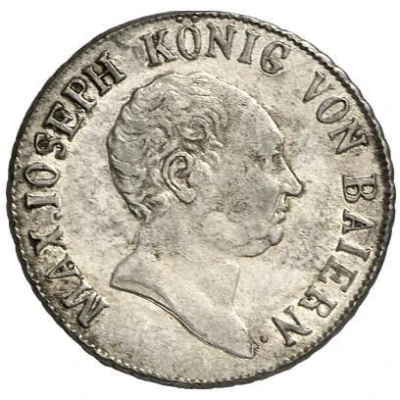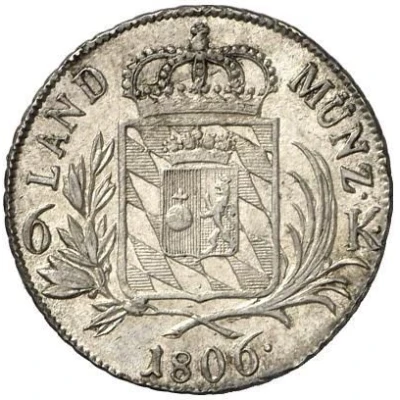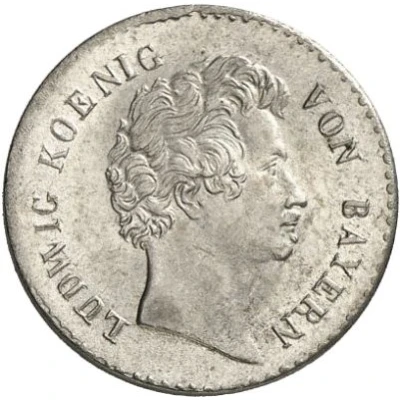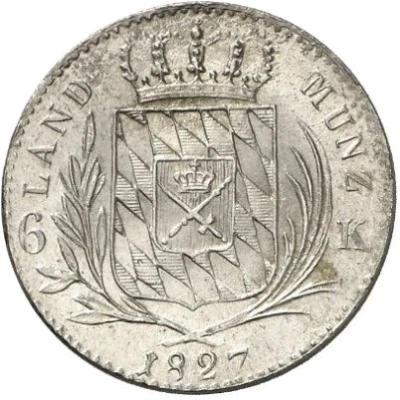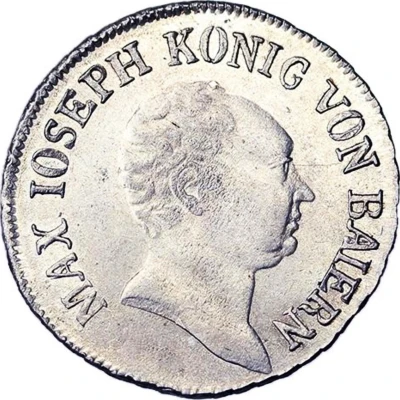
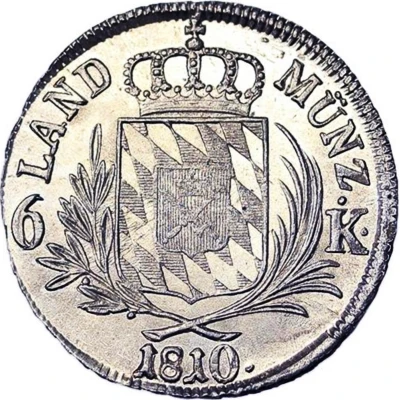

© V.L. Nummus
6 Kreuzers - Maximillian I Joseph
| Billon (.333 silver) | 2.7 g | 21 mm |
| Issuer | Kingdom of Bavaria (German States) |
|---|---|
| King | Maximilian I Joseph (1805-1825) |
| Type | Standard circulation coin |
| Years | 1806-1825 |
| Value | 6 Kreuzer Landmunze = 1⁄24 Conventionsthaler |
| Currency | Conventionsthaler (1806-1837) |
| Composition | Billon (.333 silver) |
| Weight | 2.7 g |
| Diameter | 21 mm |
| Thickness | 0.68 mm |
| Shape | Round |
| Technique | Milled |
| Orientation | Medal alignment ↑↑ |
| Demonetized | Yes |
| Updated | 2024-10-04 |
| Numista | N#23005 |
|---|---|
| Rarity index | 14% |
Reverse
Crowned arms dividing denomination, above year
Script: Latin
Lettering:
LAND MUNZ.
6 K
1810
Edge
Lettering: Ornamental pattern
Comment
Previously listed as KM#346The Kingdom of Bavaria (German: Königreich Bayern; Bavarian: Kinereich Bayern) was a German state that succeeded the former Electorate of Bavaria in 1805 and continued to exist until 1918. The Bavarian Elector Maximilian IV Joseph of the House of Wittelsbach became the first King of Bavaria in 1805 as Maximilian I Joseph. The crown would go on being held by the Wittelsbachs until the kingdom came to an end in 1918. Most of Bavaria's present-day borders were established after 1814 with the Treaty of Paris, in which Bavaria ceded Tirol and Vorarlberg to the Austrian Empire while receiving Aschaffenburg and Würzburg. With the unification of Germany into the German Empire in 1871, the kingdom became a federal state of the new Empire and was second in size, power, and wealth only to the leading state, the Kingdom of Prussia. In 1918, Bavaria became a republic, and the kingdom was thus succeeded by the current Free State of Bavaria.
Interesting fact
One interesting fact about the 6 Kreuzers coin from the Kingdom of Bavaria is that it was minted during a time of great economic and political change in Europe. The coin was issued during the reign of Maximilian I Joseph, who was a key figure in the Napoleonic Wars and the subsequent Congress of Vienna, which reshaped the political landscape of Europe in the early 19th century. The coin's mintage was a result of the economic reforms implemented by Maximilian, who aimed to modernize and strengthen the Bavarian economy. The use of Billon, a silver-copper alloy, was a common practice during this time, as it was a more affordable alternative to pure silver. Despite its relatively low value, the 6 Kreuzers coin remains a fascinating piece of history, offering a glimpse into the economic and political climate of early 19th-century Europe.
Price
| Date | Mintage | VG | F | VF | XF | AU | UNC |
|---|---|---|---|---|---|---|---|
| 1806 | - | - | - | - | - | - | |
| 1807 | - | - | - | - | - | - | |
| 1808 | - | - | - | - | - | - | |
| 1809 | - | - | - | - | - | - | |
| 1810 | - | - | - | - | - | - | |
| 1812 | - | - | - | - | - | - | |
| 1813 | - | - | - | - | - | - | |
| 1814 | - | - | - | - | - | - | |
| 1816 | - | - | - | - | - | - | |
| 1825 | - | - | - | - | - | - |
Values in the table are based on evaluations by sales realized on Internet platforms. They serve as an indication only for 6 Kreuzers - Maximillian I Joseph 1806-1825 coin.
